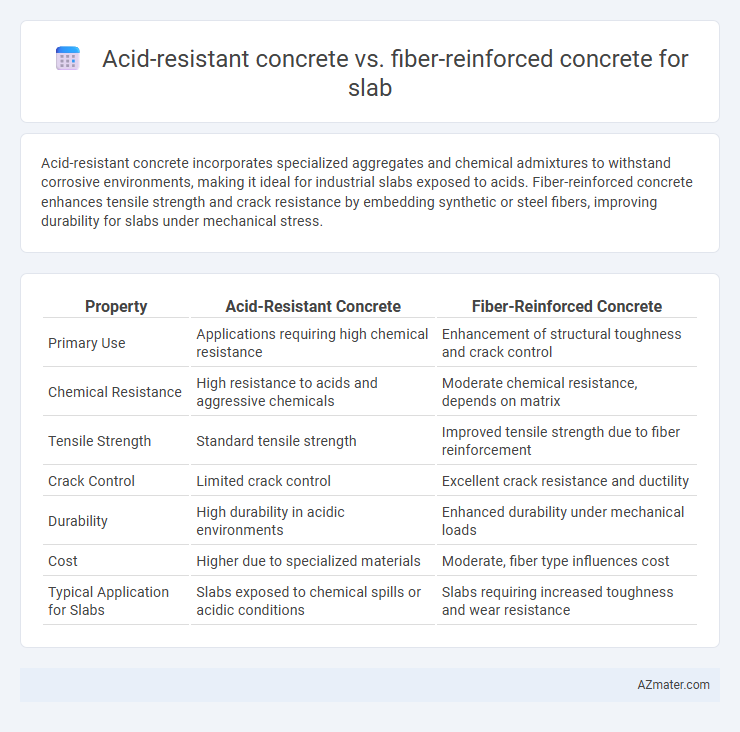Acid-resistant concrete incorporates specialized aggregates and chemical admixtures to withstand corrosive environments, making it ideal for industrial slabs exposed to acids. Fiber-reinforced concrete enhances tensile strength and crack resistance by embedding synthetic or steel fibers, improving durability for slabs under mechanical stress.
Table of Comparison
| Property | Acid-Resistant Concrete | Fiber-Reinforced Concrete |
|---|---|---|
| Primary Use | Applications requiring high chemical resistance | Enhancement of structural toughness and crack control |
| Chemical Resistance | High resistance to acids and aggressive chemicals | Moderate chemical resistance, depends on matrix |
| Tensile Strength | Standard tensile strength | Improved tensile strength due to fiber reinforcement |
| Crack Control | Limited crack control | Excellent crack resistance and ductility |
| Durability | High durability in acidic environments | Enhanced durability under mechanical loads |
| Cost | Higher due to specialized materials | Moderate, fiber type influences cost |
| Typical Application for Slabs | Slabs exposed to chemical spills or acidic conditions | Slabs requiring increased toughness and wear resistance |
Introduction to Specialized Concrete for Slabs
Acid-resistant concrete, designed to withstand harsh chemical exposure, incorporates specialized aggregates and epoxy resins to protect slab surfaces in industrial and wastewater environments. Fiber-reinforced concrete enhances slab durability and crack resistance by integrating synthetic or steel fibers, improving tensile strength and load-bearing capacity. Selecting between acid-resistant and fiber-reinforced concrete depends on environmental conditions and structural requirements for slab performance.
What is Acid-resistant Concrete?
Acid-resistant concrete is specially formulated to withstand corrosive environments where exposure to acidic substances can degrade standard concrete, making it ideal for industrial floors and chemical processing facilities. Its composition includes quartz and silica aggregates combined with acid-resistant cement or polymer-modified binders to enhance durability against sulfuric, hydrochloric, and other acids. Compared to fiber-reinforced concrete, which primarily improves tensile strength and crack resistance, acid-resistant concrete prioritizes chemical resistance to extend slab lifespan in harsh, acidic conditions.
What is Fiber-reinforced Concrete?
Fiber-reinforced concrete (FRC) incorporates fibrous materials like steel, glass, or synthetic fibers to enhance the slab's tensile strength, durability, and crack resistance. Unlike acid-resistant concrete, which is formulated with chemical additives to withstand corrosive environments, FRC improves structural integrity by distributing loads more evenly and reducing shrinkage-induced fractures. This makes fiber-reinforced concrete ideal for applications requiring enhanced mechanical performance and longevity under stress.
Key Properties Comparison: Durability and Strength
Acid-resistant concrete exhibits superior durability by withstanding aggressive chemical environments, making it ideal for slabs exposed to acidic substances, while fiber-reinforced concrete enhances tensile strength and impact resistance through embedded fibers. Acid-resistant concrete typically contains specialized aggregates and resins to prevent chemical degradation, whereas fiber-reinforced concrete relies on steel, glass, or synthetic fibers to control cracking and improve residual strength. Both types offer enhanced slab performance, but acid-resistant concrete prioritizes chemical resistance, and fiber-reinforced concrete delivers improved mechanical resilience.
Chemical Resistance in Slab Applications
Acid-resistant concrete offers superior chemical resistance for slabs exposed to harsh acidic environments, effectively preventing surface degradation and structural damage. Fiber-reinforced concrete improves mechanical properties and crack control but provides limited chemical resistance compared to acid-resistant formulations. For applications involving strong acids, acid-resistant concrete remains the preferred choice to ensure long-term durability and slab integrity.
Crack Control and Flexural Performance
Acid-resistant concrete offers superior chemical durability and crack control in environments exposed to corrosive substances, minimizing deterioration and maintaining structural integrity. Fiber-reinforced concrete enhances flexural performance by distributing internal stresses and controlling micro-cracks, resulting in increased toughness and reduced crack propagation. Combining acid-resistant properties with fiber reinforcement can optimize slab performance under aggressive chemical exposure while improving flexural strength and crack resistance.
Installation Techniques and Practical Considerations
Acid-resistant concrete slabs require meticulous surface preparation and the use of specialized curing methods to enhance chemical durability, often involving the integration of acid-resistant aggregates and polymer modifiers during mixing. Fiber-reinforced concrete slabs benefit from uniform fiber dispersion during batching and careful placement to prevent fiber balling, improving tensile strength and crack resistance without significantly altering conventional installation workflows. Practical considerations for acid-resistant concrete include handling precautions due to chemical additives and longer curing times, whereas fiber-reinforced concrete demands precise mix design adjustments and vibration techniques to ensure optimal fiber performance and surface finish.
Cost Analysis: Acid-resistant vs Fiber-reinforced Concrete
Acid-resistant concrete typically incurs higher initial costs due to specialized materials like silica fume and chemical admixtures, whereas fiber-reinforced concrete may offer cost savings through improved durability and reduced maintenance expenses over time. Fiber-reinforced concrete enhances tensile strength and crack resistance, potentially lowering repair costs in slabs exposed to mechanical stress, while acid-resistant concrete is essential for environments with chemical exposure, justifying its premium price by preventing costly acid damage. Lifecycle cost analysis reveals fiber-reinforced concrete often provides better long-term economic benefits in general use slabs, whereas acid-resistant concrete remains indispensable for applications demanding stringent chemical resistance.
Suitability for Different Environments and Industries
Acid-resistant concrete is ideal for environments with high chemical exposure, such as chemical processing plants, sewage treatment facilities, and pharmaceutical manufacturing, where resistance to corrosive acids is critical for slab durability. Fiber-reinforced concrete excels in industrial settings requiring enhanced tensile strength, impact resistance, and crack control, including warehouses, parking structures, and heavy machinery floors. Selecting between the two depends on whether chemical resistance or mechanical durability is the primary concern for the specific industrial or environmental application.
Conclusion: Choosing the Right Concrete for Your Slab
Acid-resistant concrete offers superior protection against chemical corrosion, making it ideal for industrial slabs exposed to harsh acidic environments. Fiber-reinforced concrete enhances structural durability and crack resistance, suitable for slabs requiring high tensile strength and impact resistance. Selecting the right concrete depends on the slab's exposure to corrosive agents versus the need for mechanical reinforcement, balancing chemical durability with load-bearing performance.

Infographic: Acid-resistant concrete vs Fiber-reinforced concrete for Slab
 azmater.com
azmater.com